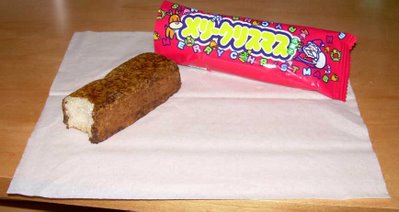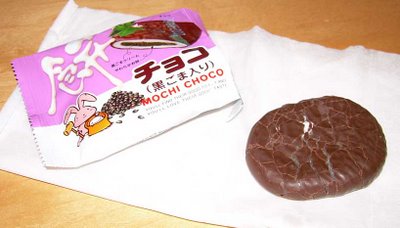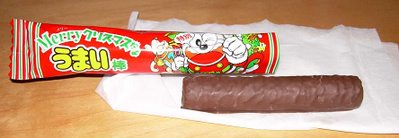One thing my husband and I used to do when we first arrived in Japan was buy some random packaged item and find out what was inside. We stopped doing that a long time ago. I rather forgot why. It struck me that it might be interesting to give that a try again. After sampling the contents of the happy package above, I believe the reason we stopped is for the same reason that you touch a hot stove once and then never do it again. Curiosity may not kill the cat but it can sure turn off his tastebuds and offer up a belly-ache.
The Christmas Pack pictured above is meant for children and only cost 99 yen at a convenience store. I didn't have great expectations of gourmet contents and I thought that it may be more interesting because it would show what sort of items are supposed to appeal to children. Unsurprisingly, the items in the bag are the kind of things you see in the candy and snack aisles which are geared toward kids in markets.

This bar resembles a cake when you see a smallish picture of it but if you click and see a larger picture, you can see it is far from a cake. It is called "Merry Christmas wheat gluten (fu) snack". I'm sure many children this year will be writing Santa and asking for special treats made of wheat gluten. The package, as best I can read, seems to be saying that it is a nutritionally-balanced snack. Among the main ingredients are brown sugar, sugar, glutinous flour, and all-purpose flour. It smells like a mixture of burnt sugar and boullion cubes. The description says something about minerals being in it. The outside is incredibly sweet and the inside is a tasteless quasi-puffed corn snack texture. It was perfectly vile when I forced myself to taste it.

This is a "black sesame mochi choco". I tried to pull this apart so you could see the center but it was too tough to separate. The chocolate just broke up. I did take a small bite of this and it out-did the wheat gluten bar in disgustingness. It was absolutely horrible. I'd try to describe it but I'm trying to allow the brain cells that retain that information to atrophy and die. Among the ingredients for this one are "chocolate" (no ingredients for the chocolate are given), corn syrup, sugar, cornstarch, seseame seed paste, mochi (like rice "taffy", though it's usually called rice "cake"), powdered milk, and soy beans. I liked how the package actually used correct English but confused "they're" and "their" (click the picture to see a larger one to clearly see the slogan). Of course, American young people who have grown up on the internet probably couldn't tell the difference between the two anyway.

This is "morokoshi wa taro" or, essentially, "corn and corm rings". Among the ingredients are corn, taro (a Japanese corm), vegetable oil, and spices. They don't smell like much of anything and taste like an airier, relatively flavorless Chee-to. I'd call these rather inoffensive to mildly pleasant because of the texture.

This one is called "Umaka Christmas" which as best I can work out means "sweet Christmas". My research indicated that "umaka" is another way of saying "umai" in a particular dialect but this may be an incorrect translation. Among the ingredients are corn grits, vegetable oil, sugar, pork extract, salt, onion powder, chicken consomme, Japanese rice (uruchi rice) and fructose. This was the only item in the package which I thought was relatively pleasant tasting. The onion powder and consomme were noticeable and the texture was fine.

This is "Merry Christmas Umai (Sweet) something**". We couldn't track down the kanji on this one without going to more trouble than it was worth. This actually wasn't bad. The chocolate on the outside tasted okay and the inside was a hollow log which tasted like and had a similar texture to Kix cereal only it was puffier and airier. Among the ingredients are sugar, vegetable oil, corn, powdered milk, chocolate mousse, cocoa, flour, non-fat powdered milk, soybean milk and flavoring.
**In the comments, Luis told me that this means "stick". His Japanese girlfriend graciously translated it. Many thanks!
If nothing else, this exercise pushed my husband and I to do some translating. It also explains why Japan imports so much corn. I think a good portion of it must be processed into these sorts of snacks.
To me, this was a classic example of something you see a fair amount of in Japan. That is, it's something which looks far better on the outside than it actually is on the inside. Maybe kids go nuts for this stuff but I bought this bag over a week ago and the QQ branch I bought it from looked to have just as many in stock as when I purchased mine.

4 comments:
Sachi says that the kanji is "bou," or "stick." I.e., the "Merry Christmas Sweet Stick."
Please thank her for her help!
Thank you for sacrificing yourself by sampling those snacks. I sometimes still mix up they're and their. Fortunately, I catch the majority of the mistakes.
I'm willing to fall on my sword occasionally for the sake of cross-cultural understanding. ;-)
Actually, I also make the mistakes with hear/here, they're/their, etc. but it's not because I don't know the difference in meaning. When you type fast, you can have a cognitive disconnect between your fingers and your meaning. You hear the words as you speak them in your mind and just type the sounds. When that happens, you can make that mistake and you'll only catch it if you proofread.
I don't assume everyone who makes that slip doesn't know. I only assume it in messages which look like this: "R U hear?"
Post a Comment